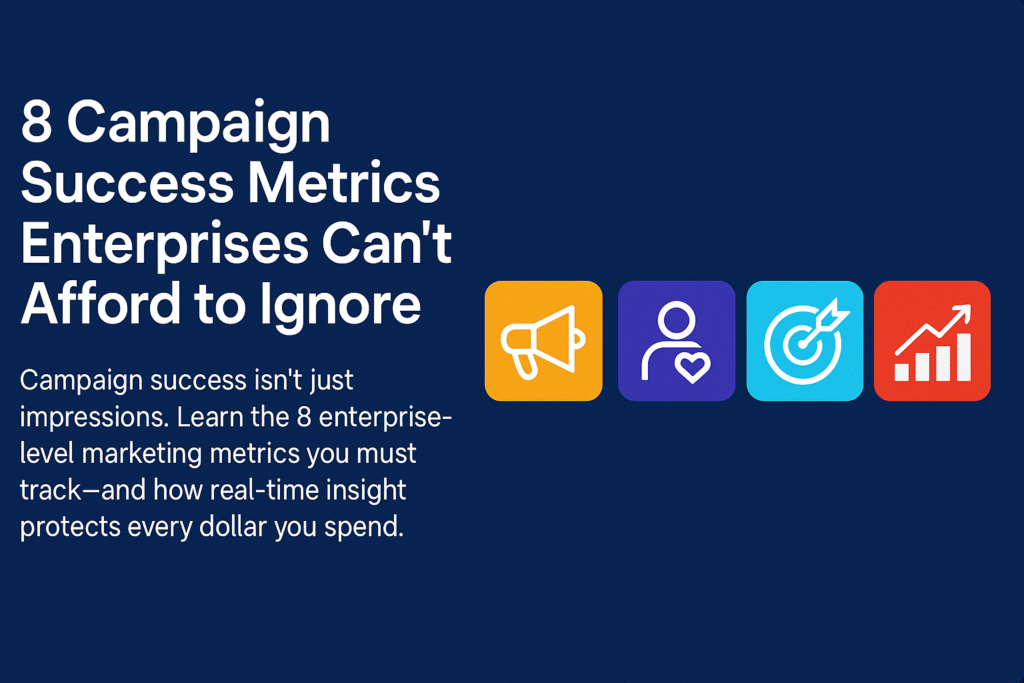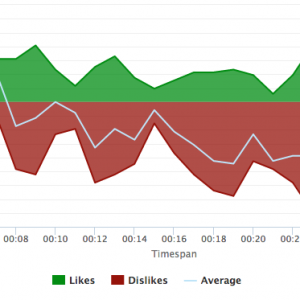
8 Campaign Success Metrics You Can’t Afford to Ignore
Campaign success isn’t just impressions. Learn the 8 enterprise-level marketing metrics you must track—and how real-time insight protects every dollar you spend.
You Can’t Optimize What You Don’t Measure—Properly
Click-through rates. Impressions. Shares. All easy to measure. None tell you much about whether your marketing actually worked.
For enterprises spending millions on campaigns, success requires a serious measurement framework—one that goes beyond vanity metrics and delivers insights tied to business outcomes. These eight campaign metrics provide a more complete picture, helping you reduce waste, adapt messaging, and drive ROI.
1. Brand Awareness
Familiarity breeds conversion—but too many teams assume awareness is a given. It’s not. Particularly in competitive, oversaturated markets.
Strong awareness metrics tell you:
-
Whether your audience even knows who you are
-
If your campaign moved that needle
-
Which channels are working hardest for you
Track with unaided recall, aided awareness surveys, and traffic lift patterns before and after campaigns.
2. Brand Consideration
It’s one thing to know a brand. It’s another to put it in your cart—real or mental.
Consideration metrics bridge the gap between awareness and intent. They tell you whether your campaign made someone think, “Hmm… maybe.”
Look for declared consideration rates (“Would you consider buying this?”), then segment by audience type, exposure, or channel.
3. Ad Recall
If your ad didn’t stick, it didn’t work.
High recall means the creative was memorable. Low recall could mean the message got lost, the branding was weak, or the delivery was confusing.
Split general recall (“Do you remember this ad?”) and brand-specific recall (“Which brand was this ad for?”). The difference often tells you if the creative made the impression—or if the logo did the heavy lifting.
4. Breakthrough
This is about more than memory—it’s about cutting through. Breakthrough measures how emotionally and cognitively disruptive your ad is in-market. That might sound like a lot, but when it’s done right, it’s what makes a brand rise above the noise.
A classic example? Volkswagen’s “Wings” ad. On first test, a scene showing an engineer’s wings slapping a woman’s backside in an elevator seemed like a light moment. Viewers found it offensive. Once that scene was cut and retested, the revised version scored far higher on engagement and favorability. Same concept, different outcome.
Sometimes the difference between a good campaign and a great one comes down to a single moment of friction.
5. Brand Favorability
Brand favorability asks one key question: Did this campaign make people like you more?
You’re not just building awareness. You’re shaping perception. And it’s surprisingly easy to get that wrong—even when recall and consideration look good.
Favorability can be gauged through post-exposure surveys, emotional association testing, or NPS change. It’s especially useful when launching new creative directions or tackling sensitive topics.
6. Purchase Intent
Not everyone’s ready to buy after seeing an ad. But some are. And tracking how many shift from “maybe later” to “probably soon” is a powerful proxy for performance.
Intent questions like “How likely are you to buy in the next 30 days?” reveal whether your campaign is activating the right stage of the funnel. Even more useful: comparing intent shifts between creative versions, placement formats, or call-to-action variants.
7. ROI / Cost Per Desired Action
Let’s be blunt: impressions are cheap. Results are not.
Your campaign should be tracked based on how much it cost to get someone to do the thing that actually matters—whether that’s visiting a product page, downloading a brochure, or signing up for a demo.
Cost Per Desired Action (CPDA) gives you a laser-focused view of whether your spend is generating business outcomes—not just digital noise.
8. Campaign Lift / Incrementality
The holy grail of campaign measurement: Did this campaign cause the results—or would they have happened anyway?
Lift studies and incrementality tests isolate the real effect of your campaign by comparing exposed audiences to matched control groups.
This kind of measurement is especially valuable in multichannel campaigns or when you’re trying to prove the value of harder-to-track formats like TV or OTT.
Connecting the Dots
Each of these metrics offers a different lens on campaign performance. But taken together, they form a complete picture—from brand impact to behavioral response.
For enterprise teams, the challenge isn’t knowing what to measure. It’s having the tools and velocity to measure them quickly enough to act. That’s where real-time platforms shine. You don’t need to wait three weeks for an answer you needed yesterday.
📥 Take it from us: Download our sample question guide
We’ve compiled the same campaign measurement questions we use across brand awareness, recall, favorability, and intent testing—designed specifically for marketers who need to move fast and defend their budget with data.
🎯 [Check back to download the Campaign Measurement Questions Checklist]
Get sharper insights. Waste less media. Prove more impact.







